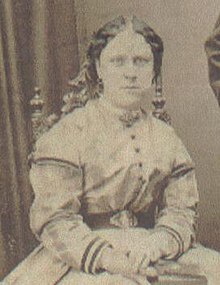Annie Chapman
Annie Chapman (* September 1841 , † September 8, 1888 in Whitechapel , London ) is considered the second victim of the infamous serial killer Jack the Ripper , who in the late summer and autumn of 1888 several prostitutes in the slum Whitechapel in London killed and maimed.
General
As with other victims of the woman killer, there are some inconsistencies regarding their personal information. Her nickname was Dark Annie . At the time of her death, she was 47 years old, penniless and in poor health. Her height was estimated to be five feet (1.55 meters). She was reportedly a brunette with blue eyes.
Earlier life
Chapman was born in September 1841 under the name Eliza Ann Smith. She was the daughter of George Smith and Ruth Chapman. Her parents married in the London borough of Paddington on February 22, 1842 , almost six months after their daughter was born. George Smith served at that time in the 2nd Regiment of the Life Guards and later worked as a domestic servant.
Marriage and children
On May 1, 1869, Annie Chapman married the coachman John Chapman, who was related on his mother's side . The couple lived in West London for a few years and had three children:
- Emily Ruth Chapman, born in 1870,
- Annie Georgina Chapman, born in 1873,
- John Chapman was born in 1880.
In 1881 they moved to rural Clewer , Berkshire , where John Chapman took a job as a coachman on a bailiff's farm . Their son John was born with a disability. The first-born daughter, Emily Ruth, died shortly after the age of twelve of meningitis . Due to the difficult fate with their children, both Annie Chapman and her husband began drinking heavily and separated in 1884 or 1885.
At the time of the death of Annie Chapman, her son John was in a charitable school and the second daughter Annie Georgina traveled with a circus by France .
Life in Whitechapel
Annie Chapman then moved to Whitechapel, where she lived with a man who made wire screens in 1886 . Therefore she was often referred to as Annie Sievey or Siffey (from English sieve , sieve). For three or four years she received a weekly allowance of ten shillings from her husband, John Chapman . With the death of the husband in late 1886, the payments ended. The sieve maker left Annie Chapman a little later due to the lack of income. One of her friends later testified that as a result of these incidents, Annie Chapman became depressed and went downhill.
In 1888 Annie Chapman lived in a common lodging house in Whitechapel. Occasionally she was with the masonry laborer Edward Stanley, made a little crocheting, made sofa covers, and sold flowers. She also supplemented her income with occasional prostitution . Acquaintances described her as harmless and as the most cultured woman in the area, although she drank regularly and her health was bad.
About a week before she died, Annie Chapman felt bad after being injured in an argument by her roommate, Eliza Cooper. It was reported that the two rivals were fighting over the affection of Edward Stanley.
Shortly after midnight on the morning of her death, Annie Chapman (similar to Mary Ann Nichols ) went out to raise money for her housing. One Elizabeth Long stated that at 5:30 a.m. she saw a man and a woman who she believed were Chapman outside the house at 29 Hanbury Street. If this is correct, Long would be the last Chapman to see alive. However, this contradicts the results of the later autopsy.
The discovery of the corpse
Chapman's body was found in the back yard of 29 Hanbury Street at around 6 a.m. on September 8, 1888 .
Chapman was found with his throat cut . Her abdomen was cut open and completely gutted. The entrails had been thrown over her right shoulder. Her killer had taken her uterus and part of the abdominal wall around her belly button .
This act was the riskiest of the murderer's crimes. Chapman was probably killed around 5:30 a.m. in the courtyard of a house inhabited by 17 people, some of whom were already awake at the time and could see the courtyard. The only escape route was through a narrow passage through the building, from which the worker who found Chapman's body came. However, the residents had seen and heard nothing at the time of the crime.
Doctor George Bagster Phillips, who autopsied the body , stated that the current poor health was caused by tuberculosis . Later researchers suggested that the health problems were caused in part by syphilis . Phillips also found that Chapman had been dead for at least two hours and sober at the time of death.
literature
- Philip Sugden: The Complete History of Jack the Ripper. Carroll & Graf Publishing, New York NY 1995, ISBN 0-7867-0276-1 , is widely regarded as one of the best books on the subject.
- Hendrik Püstow, Thomas Schachner: Jack the Ripper. Anatomy of a legend. Militzke Verlag, Leipzig 2006, ISBN 3-86189-753-9 .
- Hallie Rubenhold : The Five: The Untold Lives of the Women Killed by Jack the Ripper. Doubleday, 2019, ISBN 978-0857524485 .
Web links
- Annie Chapman . In: jacktheripper.de
- Annie Chapman . In: casebook.org (contains numerous English-language articles on the case and reproduces many original sources)
| personal data | |
|---|---|
| SURNAME | Chapman, Annie |
| ALTERNATIVE NAMES | Dark Annie (nickname) |
| BRIEF DESCRIPTION | English prostitute, victim of Jack the Ripper |
| DATE OF BIRTH | September 1841 |
| DATE OF DEATH | September 8, 1888 |
| Place of death | Whitechapel , London |
